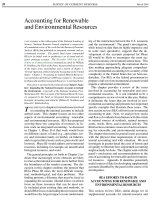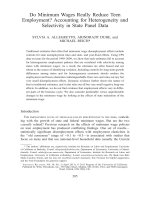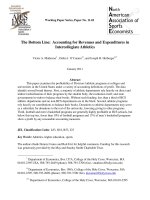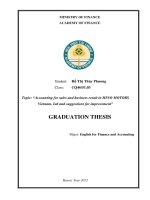Ch07 accounting for state and local governmental units proprietary and fiduciary funds
Bạn đang xem bản rút gọn của tài liệu. Xem và tải ngay bản đầy đủ của tài liệu tại đây (238.44 KB, 33 trang )
Chapter 7: Accounting for State
and Local Governmental Units –
Proprietary and Fiduciary Funds
Proprietary and Fiduciary Funds:
Objectives
1. Review the appropriate accounting and financial
reporting for proprietary funds.
2. Recognize the proper treatment of internal service funds
in the government-wide statements.
3. Introduce the differences between a proprietary fund
statement of cash flows and its commercial business
counterpart.
4. Prepare journal entries and fund financial statements for
fiduciary funds.
5. Learn about GASB guidance for pension fund
accounting.
Accounting for State and Local Governmental Units – Proprietary
and Fiduciary Funds
1: Proprietary Funds
Accounting for Proprietary Funds
• Model
CA + NCA – CL – NCL = Net assets
• Use accrual accounting
• Net assets
– Invested in capital assets net of related debt
– Restricted net assets
– Unrestricted net assets
• Two types
– Internal service funds
– Enterprise funds
Internal Service Funds
• Use for government activities that provide goods and
services to other departments or agencies of that same
governmental unit
• Central stores/ purchasing
• Motor pools
• Print shop
• Might be started with transfers from general fund
and/or contributed capital from other sources
• Main source of revenues is other funds
• Use "Due from …" rather than accounts receivable
ISF – Entries (1 of 3)
Cash
200
Motor vehicles
120
Other financing source - nonreciprocal
transfer from general fund
200
Contributed capital from municipality
120
• A village begins a central motor pool with $200 from the
general fund and a contribution of vehicles
– The Other financing source and Contributed capital
increase the ISF's net assets
ISF – Entries (2 of 3)
ISF
GF
SRF
Due from general fund
100
Due from special revenue fund
30
Service revenues
130
Expenditures
100
Due to internal service fund
100
Expenditures
30
Due to internal service fund
30
• It provides motor pool services to the general fund and
special revenue fund and bills them $100 and $30
• The general fund and special revenue fund will record the
bills received as expenditures
ISF – Entries (3 of 3)
ISF
Due from general fund
GF
100
Cash
100
Due to internal service fund
Cash
100
100
• The internal service fund collects the $100 due from the
general fund
• The general fund will record the payment of its liability
ISF – Other Transactions
• Most other transactions parallel those of businesses
– Use expenses, not expenditures
– Record acquisition, disposition, and depreciation of
fixed assets
– Income is closed to unrestricted net assets
Enterprise Funds
• Use for governmental activities
– Financed and operated like a business
– Provide goods and services to general public
• Utilities, civic centers, golf clubs
• Might start with funds transferred and contributions
• Main revenues from general public, but some from
other departments of the government
• Use "Accounts Receivable" for general public and
others and "Due from …" for other funds of this
governmental unit
EF – Entries (1 of 4)
10
Restricted cash
Customer deposits
10
• Utility-type enterprise funds often charge customer
deposits
– Amounts given as deposits are restricted cash, not
included in current assets
– Customer deposits are liabilities, may be current or
long term
• Deposits may be returned or applied against the
customers accounts receivable
EF – Entries (2 of 4)
Due from other governments
50
Contributed capital - capital grant
50
Equipment
65
Cash
65
Cash
50
Due from other governments
50
• Grants to acquire or enhance capital assets are recorded
as contributed capital
• Grants to help fund operating activities are nonoperating revenue
• The three entries represent:
– Notice of grant to fund new equipment
– Acquire equipment, eligible to receive cash
– Receive grant monies
EF – Entries (3 of 4)
EF
500
Accounts receivable
40
Due from general fund
Service revenues
GF
40
Expenditures
Due to internal service fund
540
• Provide services and bill general public $500 and its
own governmental unit $40
• General fund records the bill of $40
40
EF – Entries (4 of 4)
EF
GF
490
Cash
Accounts receivable
450
Due from general fund
40
40
Due to internal service fund
Cash
• Collect from general public and the general fund
• The general fund records the payment
• The enterprise fund will use allowances for uncollectibles and bad debt
expense, like business enterprises
40
EF – Other Transactions
• Most follow that of businesses
• Income is closed to unrestricted net assets
• Enterprise funds may issue bonds
– General obligation or revenue bonds
• Record as bonds payable
• Use effective interest method
• Premiums or discounts
• Capital leases
– Record leased assets and lease obligation
Accounting for State and Local Governmental Units – Proprietary
and Fiduciary Funds
2: Internal Service Funds in
Government-wide Statements
Proprietary Fund Financial
Statements
Three statements
1. Statement of net assets (balance sheet)
2. Statement of revenues, expenses, and changes in
net assets
3. Statement of cash flows
Use separate columns for each significant enterprise fund,
other enterprise funds, total enterprise funds and total
internal service funds
– Internal service funds are not added to enterprise
funds
– ISFs are governmental activities
– EFs are business type activities
Columnar presentation is not included for brevity
Statement of Net Assets
Cash
$720
Receivables, net
261
Due from other
32
funds
Supplies
62
Total current assets
$1,075
Restricted cash
$185
Land
95
Buildings and
1,990
equipment
Vehicles
220
Accumulated
(1,005)
depreciation
Total noncurrent
$1,485
assets
Total assets
$2,560
Accounts payable
Due to other funds
Other current
liabilities
Customer deposits
Compensated
absences
Bonds and notes
payable
Total liabilities
Net assets:
Invested in capital
assets, net of related
debt
Restricted
Unrestricted
Total net assets
$68
4
129
$201
$185
295
465
945
$1,146
$575
270
569
$1,414
Statement of Revenues, Expenses
and Changes in Net Assets
Operating revenues
Operating expenses
Operating income
$1,220
(936)
Nonoperating revenues (expenses):
$284
Miscellaneous revenue
2
Interest expense
(19)
Income (loss) before contributions and transfers $267
Capital contributions
50
Transfers in
1
Transfers out
(19)
Change in net assets
$299
Total net assets, 7/1/08
1,200
Total net assets, 6/30/09
$1,499
Government-wide Statements
• Internal service funds are included with governmental
funds
– All represent governmental activities
• Enterprise funds displayed in a single column labeled
Business-type activities
• ISF and EF already use accrual accounting
• Interfund balances: either
• Eliminate
• Show interfund balances separate from
other assets/ liabilities
• No reconciliations needed for ISF and EF
ISF in Financial Statements
• In the Proprietary fund statements:
– Internal service funds are in a separate column
• Separately, to the side of the total for businesstype/ enterprise funds
• Not added to those enterprise funds
• In the Government-wide statements:
– Internal service funds plus governmental funds are
shown as one total
• Labeled as governmental-type activities
• Governmental-type and business-type activities
are the added together
Accounting for State and Local Governmental Units – Proprietary
and Fiduciary Funds
3: Proprietary Funds Statement of
Cash Flows
Cash Flow Categories
Four cash flow categories:
1. Cash flows from operations
2. Cash flows from noncapital financing activities
3. Cash flows from capital and related financing activities
4. Cash flows from investing activities
Compared to for-profit enterprises
– Capital expenditures are removed from other investing
activities
– Their related financing activities are taken from other
financing activities
– Capital expenditures and related financing have their
own category
Statement of Cash Flows
Cash flows from operations:
Cash received from customers
Cash paid to suppliers
Cash paid for other expenses
Net cash provided by operations
Cash flows from noncapital financing activities:
Cash from general fund
Cash flows from capital and related financing activities:
Purchase of equipment
Payment on capital debt
Net cash provided by capital and related financing
Cash flows from investing activities:
Interest and dividends
Net increase in unrestricted cash
Cash balance, 7/1/08
Cash balance, 6/30/08
$1,161
(326)
(471)
($18)
(87)
$364
3
(105)
1
$263
457
$720
Accounting for State and Local Governmental Units – Proprietary
and Fiduciary Funds
4: Fiduciary Funds









